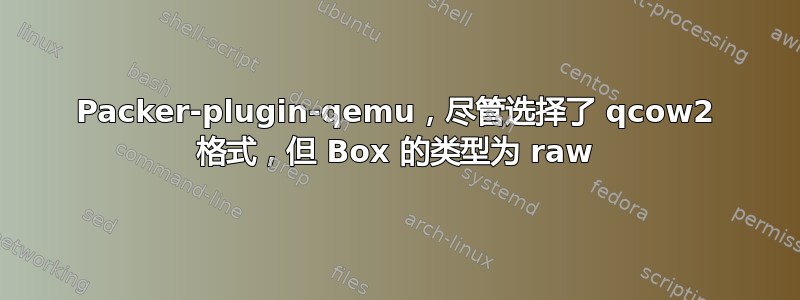
完成后packer build,当我检查它的文件格式时,尽管选择了 qcow2 格式,qemu-img但virt-install两者都告诉我文件格式是原始格式。
打包器构建命令之后立即执行 qemu-img 命令
$ sudo qemu-img info output/bastillebox-installer-box_qemu_archlinux-2023-05.qcow2
image: ./bastillebox-installer-box_qemu_archlinux-2023-05.qcow2
file format: raw
virtual size: 1.42 GiB (1522309120 bytes)
disk size: 1.42 GiB
Child node '/file':
filename: ./bastillebox-installer-box_qemu_archlinux-2023-05.qcow2
protocol type: file
file length: 1.42 GiB (1522309120 bytes)
disk size: 1.42 GiB
以下是我的 packer_template 文件:
my_packer_template.pkr.hcl
packer {
required_plugins {
qemu = {
version = ">= 1.0.9"
source = "github.com/hashicorp/qemu"
}
}
}
variable "ssh_private_key_file" {
type = string
default = "~/.ssh/id_bas"
}
variable "ssh_timeout" {
type = string
default = "20m"
validation {
condition = can(regex("[0-9]+[smh]", var.ssh_timeout))
error_message = "The ssh_timeout value must be a number followed by the letter s(econds), m(inutes), or h(ours)."
}
}
variable "ssh_username" {
description = "Unpriviledged user to create."
type = string
default = "bas"
}
locals {
boot_command_qemu = [
"<wait5><enter><wait2m>",
"curl -O http://{{ .HTTPIP }}:{{ .HTTPPort }}/${local.kickstart_script} && chmod +x ${local.kickstart_script} && ./${local.kickstart_script} {{ .HTTPPort }}<enter>",
]
boot_command_virtualbox = [
"<enter><wait2m>",
"curl -O http://{{ .HTTPIP }}:{{ .HTTPPort }}/${local.kickstart_script} && chmod +x ${local.kickstart_script} && ./${local.kickstart_script} {{ .HTTPPort }}<enter>",
]
cpus = 1
disk_size = "4G"
efi_firmware_code = "/usr/share/edk2/x64/OVMF_CODE.4m.fd"
efi_firmware_vars = "/usr/share/edk2/x64/OVMF_VARS.4m.fd"
headless = "false"
iso_checksum = "sha256:329b00c3e8cf094a28688c50a066b5ac6352731ccdff467f9fd7155e52d36cec"
iso_url = "https://mirror.cj2.nl/archlinux/iso/2023.05.03/archlinux-x86_64.iso"
kickstart_script = "initLiveVM.sh"
machine_type = "q35"
memory = 4096
http_directory = "srv"
vm_name = "bastille-installer"
write_zeros = "true"
}
source "qemu" "archlinux" {
accelerator = "kvm"
boot_command = local.boot_command_qemu
boot_wait = "1s"
cpus = local.cpus
disk_interface = "virtio"
disk_size = local.disk_size
efi_boot = true
efi_firmware_code = local.efi_firmware_code
efi_firmware_vars = local.efi_firmware_vars
format = "qcow2"
headless = local.headless
http_directory = local.http_directory
iso_url = local.iso_url
iso_checksum = local.iso_checksum
machine_type = local.machine_type
memory = local.memory
net_device = "virtio-net"
shutdown_command = "sudo systemctl start poweroff.timer"
ssh_handshake_attempts = 500
ssh_port = 22
ssh_private_key_file = var.ssh_private_key_file
ssh_timeout = var.ssh_timeout
ssh_username = var.ssh_username
ssh_wait_timeout = var.ssh_timeout
vm_name = "${local.vm_name}.qcow2"
}
build {
name = "bastille-installer"
sources = ["source.qemu.archlinux"]
provisioner "file" {
destination = "/tmp/"
source = "./files"
}
provisioner "shell" {
only = ["qemu.archlinux"]
execute_command = "{{ .Vars }} sudo -E -S bash '{{ .Path }}'"
expect_disconnect = true
scripts = [
"scripts/liveVM.sh",
"scripts/tables.sh",
"scripts/partitions.sh",
"scripts/base.sh",
"scripts/bootloader.sh",
"scripts/pacman.sh",
"scripts/setup.sh"
]
}
provisioner "shell" {
execute_command = "{{ .Vars }} WRITE_ZEROS=${local.write_zeros} sudo -E -S bash '{{ .Path }}'"
script = "scripts/cleanup.sh"
}
post-processor "vagrant" {
output = "output/${local.vm_name}_${source.type}_${source.name}-${formatdate("YYYY-MM", timestamp())}.qcow2"
vagrantfile_template = "templates/vagrantfile.tpl"
}
}
我的完整项目如下 https://github.com/safenetwork-community/bastillebox-installer-box/tree/arch
为什么是打包插件 qemu尽管我已经这样配置了,但没有生成 qcow2 格式的盒子?
答案1
后处理器创建一个 vagrant box 文件。
我不知道如何处理这个问题,但至少这给出了问题的答案。
post-processor "vagrant" {
output = "output/${local.vm_name}_${source.type}_${source.name}-${formatdate("YYYY-MM", timestamp())}.qcow2"
vagrantfile_template = "templates/vagrantfile.tpl"
}


